NUR104: Case Studies on Older Adults - Biophysical, Psychosocial Care
VerifiedAdded on 2023/06/04
|13
|2796
|239
Case Study
AI Summary
This assignment presents three case studies focusing on older adults and their specific healthcare needs. The first case study addresses Rob, who suffers from dementia, and analyzes the biophysical and psychosocial processes pertinent to his condition, identifies the Alzheimer’s Disease Assessment Scale-Cognitive Subscale as an appropriate assessment tool, discusses priorities of care such as person-centered care, and examines equity, rights, and access issues. The second case study focuses on Dulcie, highlighting biophysical changes like difficulty managing daily tasks and psychosocial processes such as short-term memory loss. The Malnutrition Universal Screening Tool (MUST) is identified as a suitable assessment tool, and priorities of care include addressing nutritional status and dietary needs. The final case study examines Betty, an older adult at risk of falls, discussing biophysical changes leading to immobility and psychological processes contributing to fall risk. The Fall Risk Assessment Tool (FRAT) is proposed for assessment, with priorities of care including fall risk screening and management strategies. Each case study also addresses equity, rights, and access issues relevant to the patient's care.

Running head: Context Of Person : The Older Person And Family
Context Of Person : The Older Person And Family
Context Of Person : The Older Person And Family
Paraphrase This Document
Need a fresh take? Get an instant paraphrase of this document with our AI Paraphraser
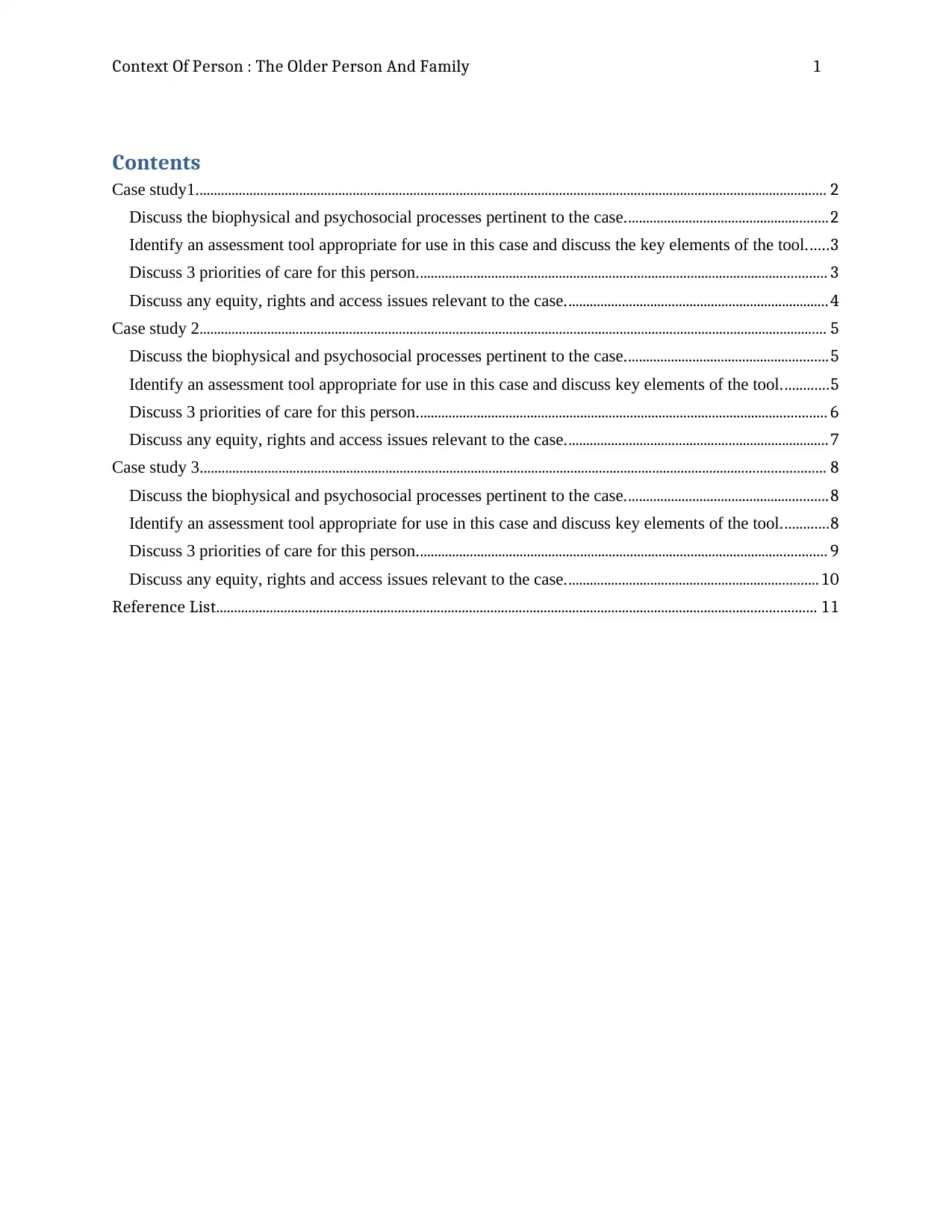
Context Of Person : The Older Person And Family 1
Contents
Case study1................................................................................................................................................................................. 2
Discuss the biophysical and psychosocial processes pertinent to the case.........................................................2
Identify an assessment tool appropriate for use in this case and discuss the key elements of the tool......3
Discuss 3 priorities of care for this person................................................................................................................... 3
Discuss any equity, rights and access issues relevant to the case..........................................................................4
Case study 2................................................................................................................................................................................ 5
Discuss the biophysical and psychosocial processes pertinent to the case.........................................................5
Identify an assessment tool appropriate for use in this case and discuss key elements of the tool.............5
Discuss 3 priorities of care for this person................................................................................................................... 6
Discuss any equity, rights and access issues relevant to the case..........................................................................7
Case study 3............................................................................................................................................................................... 8
Discuss the biophysical and psychosocial processes pertinent to the case.........................................................8
Identify an assessment tool appropriate for use in this case and discuss key elements of the tool.............8
Discuss 3 priorities of care for this person................................................................................................................... 9
Discuss any equity, rights and access issues relevant to the case.......................................................................10
Reference List........................................................................................................................................................................ 11
Contents
Case study1................................................................................................................................................................................. 2
Discuss the biophysical and psychosocial processes pertinent to the case.........................................................2
Identify an assessment tool appropriate for use in this case and discuss the key elements of the tool......3
Discuss 3 priorities of care for this person................................................................................................................... 3
Discuss any equity, rights and access issues relevant to the case..........................................................................4
Case study 2................................................................................................................................................................................ 5
Discuss the biophysical and psychosocial processes pertinent to the case.........................................................5
Identify an assessment tool appropriate for use in this case and discuss key elements of the tool.............5
Discuss 3 priorities of care for this person................................................................................................................... 6
Discuss any equity, rights and access issues relevant to the case..........................................................................7
Case study 3............................................................................................................................................................................... 8
Discuss the biophysical and psychosocial processes pertinent to the case.........................................................8
Identify an assessment tool appropriate for use in this case and discuss key elements of the tool.............8
Discuss 3 priorities of care for this person................................................................................................................... 9
Discuss any equity, rights and access issues relevant to the case.......................................................................10
Reference List........................................................................................................................................................................ 11
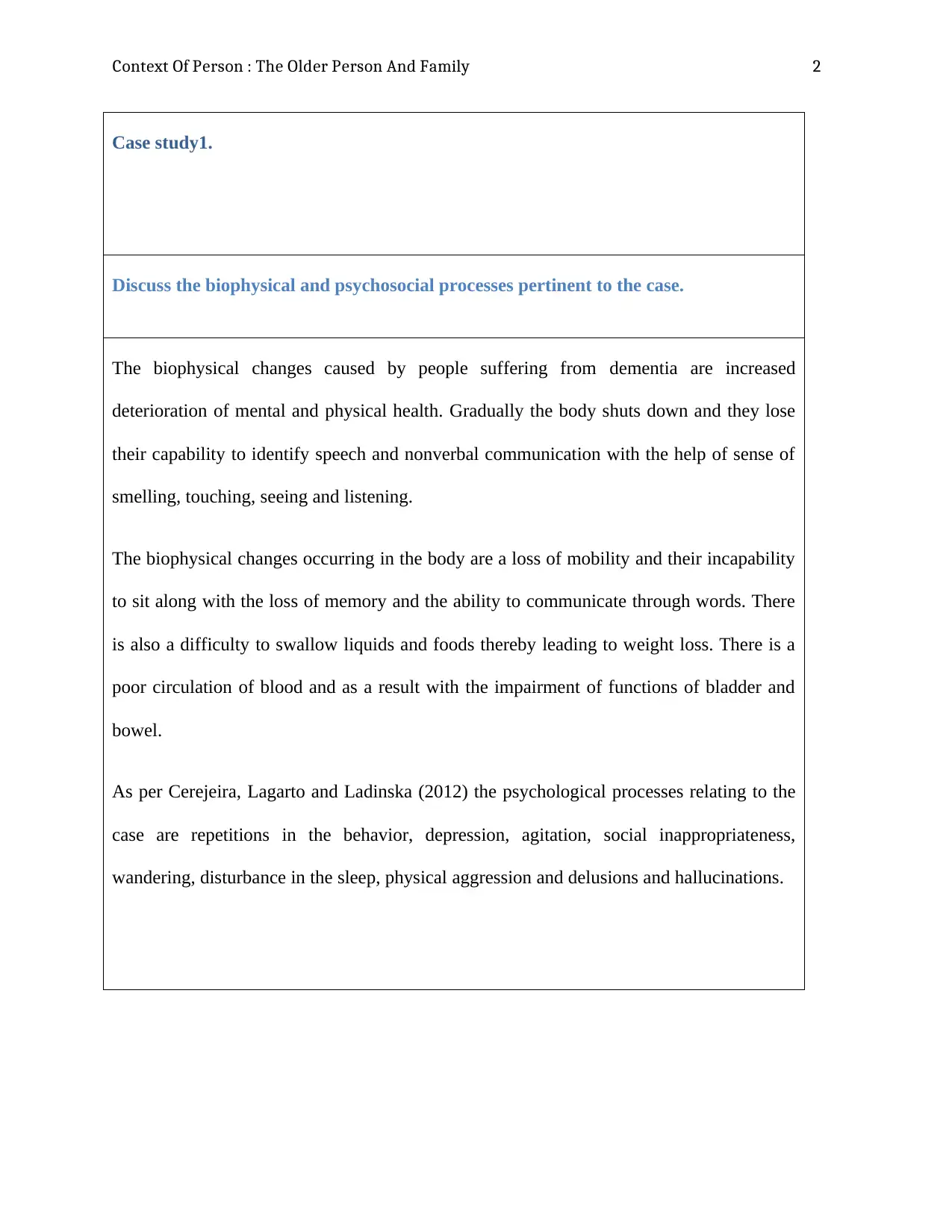
Context Of Person : The Older Person And Family 2
Case study1.
Discuss the biophysical and psychosocial processes pertinent to the case.
The biophysical changes caused by people suffering from dementia are increased
deterioration of mental and physical health. Gradually the body shuts down and they lose
their capability to identify speech and nonverbal communication with the help of sense of
smelling, touching, seeing and listening.
The biophysical changes occurring in the body are a loss of mobility and their incapability
to sit along with the loss of memory and the ability to communicate through words. There
is also a difficulty to swallow liquids and foods thereby leading to weight loss. There is a
poor circulation of blood and as a result with the impairment of functions of bladder and
bowel.
As per Cerejeira, Lagarto and Ladinska (2012) the psychological processes relating to the
case are repetitions in the behavior, depression, agitation, social inappropriateness,
wandering, disturbance in the sleep, physical aggression and delusions and hallucinations.
Case study1.
Discuss the biophysical and psychosocial processes pertinent to the case.
The biophysical changes caused by people suffering from dementia are increased
deterioration of mental and physical health. Gradually the body shuts down and they lose
their capability to identify speech and nonverbal communication with the help of sense of
smelling, touching, seeing and listening.
The biophysical changes occurring in the body are a loss of mobility and their incapability
to sit along with the loss of memory and the ability to communicate through words. There
is also a difficulty to swallow liquids and foods thereby leading to weight loss. There is a
poor circulation of blood and as a result with the impairment of functions of bladder and
bowel.
As per Cerejeira, Lagarto and Ladinska (2012) the psychological processes relating to the
case are repetitions in the behavior, depression, agitation, social inappropriateness,
wandering, disturbance in the sleep, physical aggression and delusions and hallucinations.
⊘ This is a preview!⊘
Do you want full access?
Subscribe today to unlock all pages.

Trusted by 1+ million students worldwide
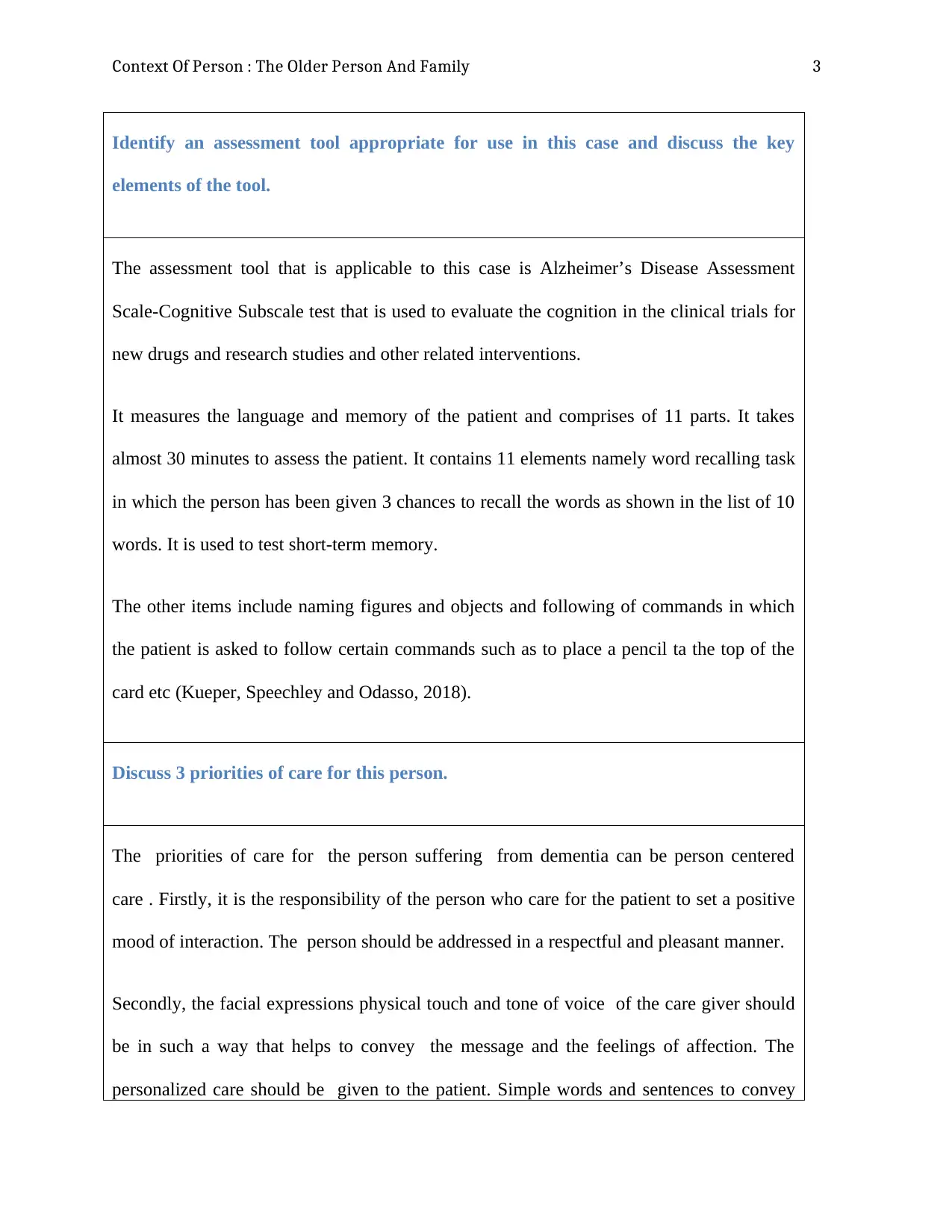
Context Of Person : The Older Person And Family 3
Identify an assessment tool appropriate for use in this case and discuss the key
elements of the tool.
The assessment tool that is applicable to this case is Alzheimer’s Disease Assessment
Scale-Cognitive Subscale test that is used to evaluate the cognition in the clinical trials for
new drugs and research studies and other related interventions.
It measures the language and memory of the patient and comprises of 11 parts. It takes
almost 30 minutes to assess the patient. It contains 11 elements namely word recalling task
in which the person has been given 3 chances to recall the words as shown in the list of 10
words. It is used to test short-term memory.
The other items include naming figures and objects and following of commands in which
the patient is asked to follow certain commands such as to place a pencil ta the top of the
card etc (Kueper, Speechley and Odasso, 2018).
Discuss 3 priorities of care for this person.
The priorities of care for the person suffering from dementia can be person centered
care . Firstly, it is the responsibility of the person who care for the patient to set a positive
mood of interaction. The person should be addressed in a respectful and pleasant manner.
Secondly, the facial expressions physical touch and tone of voice of the care giver should
be in such a way that helps to convey the message and the feelings of affection. The
personalized care should be given to the patient. Simple words and sentences to convey
Identify an assessment tool appropriate for use in this case and discuss the key
elements of the tool.
The assessment tool that is applicable to this case is Alzheimer’s Disease Assessment
Scale-Cognitive Subscale test that is used to evaluate the cognition in the clinical trials for
new drugs and research studies and other related interventions.
It measures the language and memory of the patient and comprises of 11 parts. It takes
almost 30 minutes to assess the patient. It contains 11 elements namely word recalling task
in which the person has been given 3 chances to recall the words as shown in the list of 10
words. It is used to test short-term memory.
The other items include naming figures and objects and following of commands in which
the patient is asked to follow certain commands such as to place a pencil ta the top of the
card etc (Kueper, Speechley and Odasso, 2018).
Discuss 3 priorities of care for this person.
The priorities of care for the person suffering from dementia can be person centered
care . Firstly, it is the responsibility of the person who care for the patient to set a positive
mood of interaction. The person should be addressed in a respectful and pleasant manner.
Secondly, the facial expressions physical touch and tone of voice of the care giver should
be in such a way that helps to convey the message and the feelings of affection. The
personalized care should be given to the patient. Simple words and sentences to convey
Paraphrase This Document
Need a fresh take? Get an instant paraphrase of this document with our AI Paraphraser
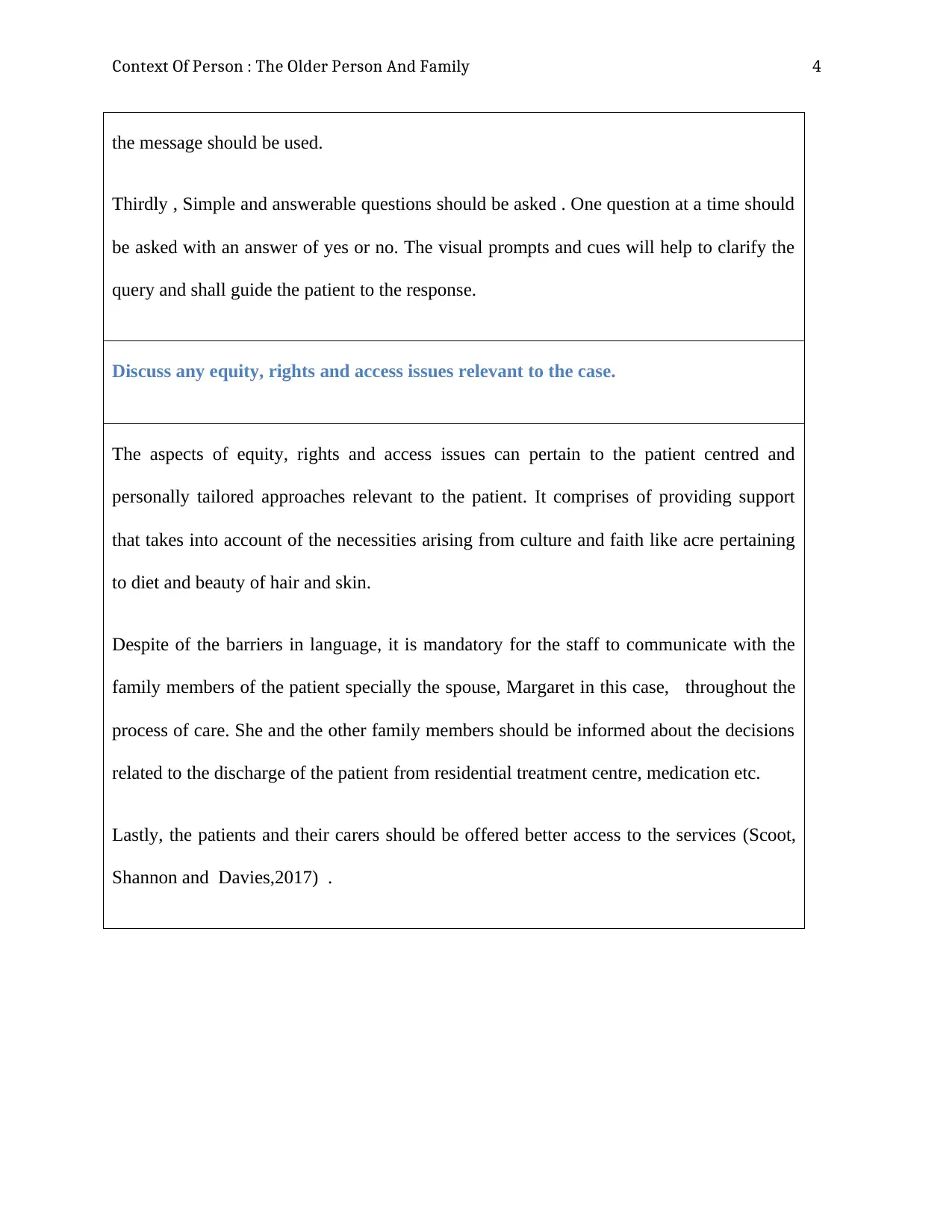
Context Of Person : The Older Person And Family 4
the message should be used.
Thirdly , Simple and answerable questions should be asked . One question at a time should
be asked with an answer of yes or no. The visual prompts and cues will help to clarify the
query and shall guide the patient to the response.
Discuss any equity, rights and access issues relevant to the case.
The aspects of equity, rights and access issues can pertain to the patient centred and
personally tailored approaches relevant to the patient. It comprises of providing support
that takes into account of the necessities arising from culture and faith like acre pertaining
to diet and beauty of hair and skin.
Despite of the barriers in language, it is mandatory for the staff to communicate with the
family members of the patient specially the spouse, Margaret in this case, throughout the
process of care. She and the other family members should be informed about the decisions
related to the discharge of the patient from residential treatment centre, medication etc.
Lastly, the patients and their carers should be offered better access to the services (Scoot,
Shannon and Davies,2017) .
the message should be used.
Thirdly , Simple and answerable questions should be asked . One question at a time should
be asked with an answer of yes or no. The visual prompts and cues will help to clarify the
query and shall guide the patient to the response.
Discuss any equity, rights and access issues relevant to the case.
The aspects of equity, rights and access issues can pertain to the patient centred and
personally tailored approaches relevant to the patient. It comprises of providing support
that takes into account of the necessities arising from culture and faith like acre pertaining
to diet and beauty of hair and skin.
Despite of the barriers in language, it is mandatory for the staff to communicate with the
family members of the patient specially the spouse, Margaret in this case, throughout the
process of care. She and the other family members should be informed about the decisions
related to the discharge of the patient from residential treatment centre, medication etc.
Lastly, the patients and their carers should be offered better access to the services (Scoot,
Shannon and Davies,2017) .
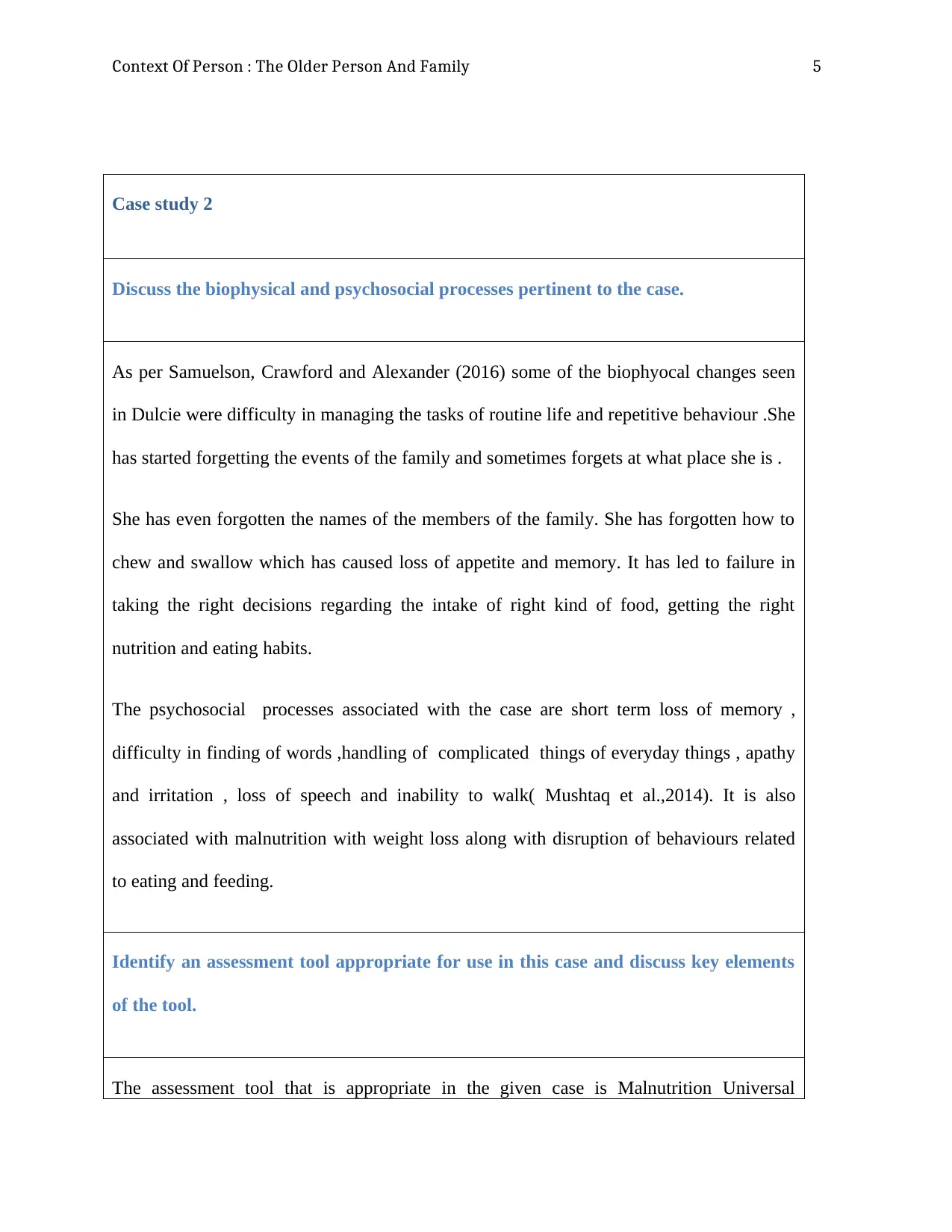
Context Of Person : The Older Person And Family 5
Case study 2
Discuss the biophysical and psychosocial processes pertinent to the case.
As per Samuelson, Crawford and Alexander (2016) some of the biophyocal changes seen
in Dulcie were difficulty in managing the tasks of routine life and repetitive behaviour .She
has started forgetting the events of the family and sometimes forgets at what place she is .
She has even forgotten the names of the members of the family. She has forgotten how to
chew and swallow which has caused loss of appetite and memory. It has led to failure in
taking the right decisions regarding the intake of right kind of food, getting the right
nutrition and eating habits.
The psychosocial processes associated with the case are short term loss of memory ,
difficulty in finding of words ,handling of complicated things of everyday things , apathy
and irritation , loss of speech and inability to walk( Mushtaq et al.,2014). It is also
associated with malnutrition with weight loss along with disruption of behaviours related
to eating and feeding.
Identify an assessment tool appropriate for use in this case and discuss key elements
of the tool.
The assessment tool that is appropriate in the given case is Malnutrition Universal
Case study 2
Discuss the biophysical and psychosocial processes pertinent to the case.
As per Samuelson, Crawford and Alexander (2016) some of the biophyocal changes seen
in Dulcie were difficulty in managing the tasks of routine life and repetitive behaviour .She
has started forgetting the events of the family and sometimes forgets at what place she is .
She has even forgotten the names of the members of the family. She has forgotten how to
chew and swallow which has caused loss of appetite and memory. It has led to failure in
taking the right decisions regarding the intake of right kind of food, getting the right
nutrition and eating habits.
The psychosocial processes associated with the case are short term loss of memory ,
difficulty in finding of words ,handling of complicated things of everyday things , apathy
and irritation , loss of speech and inability to walk( Mushtaq et al.,2014). It is also
associated with malnutrition with weight loss along with disruption of behaviours related
to eating and feeding.
Identify an assessment tool appropriate for use in this case and discuss key elements
of the tool.
The assessment tool that is appropriate in the given case is Malnutrition Universal
⊘ This is a preview!⊘
Do you want full access?
Subscribe today to unlock all pages.

Trusted by 1+ million students worldwide
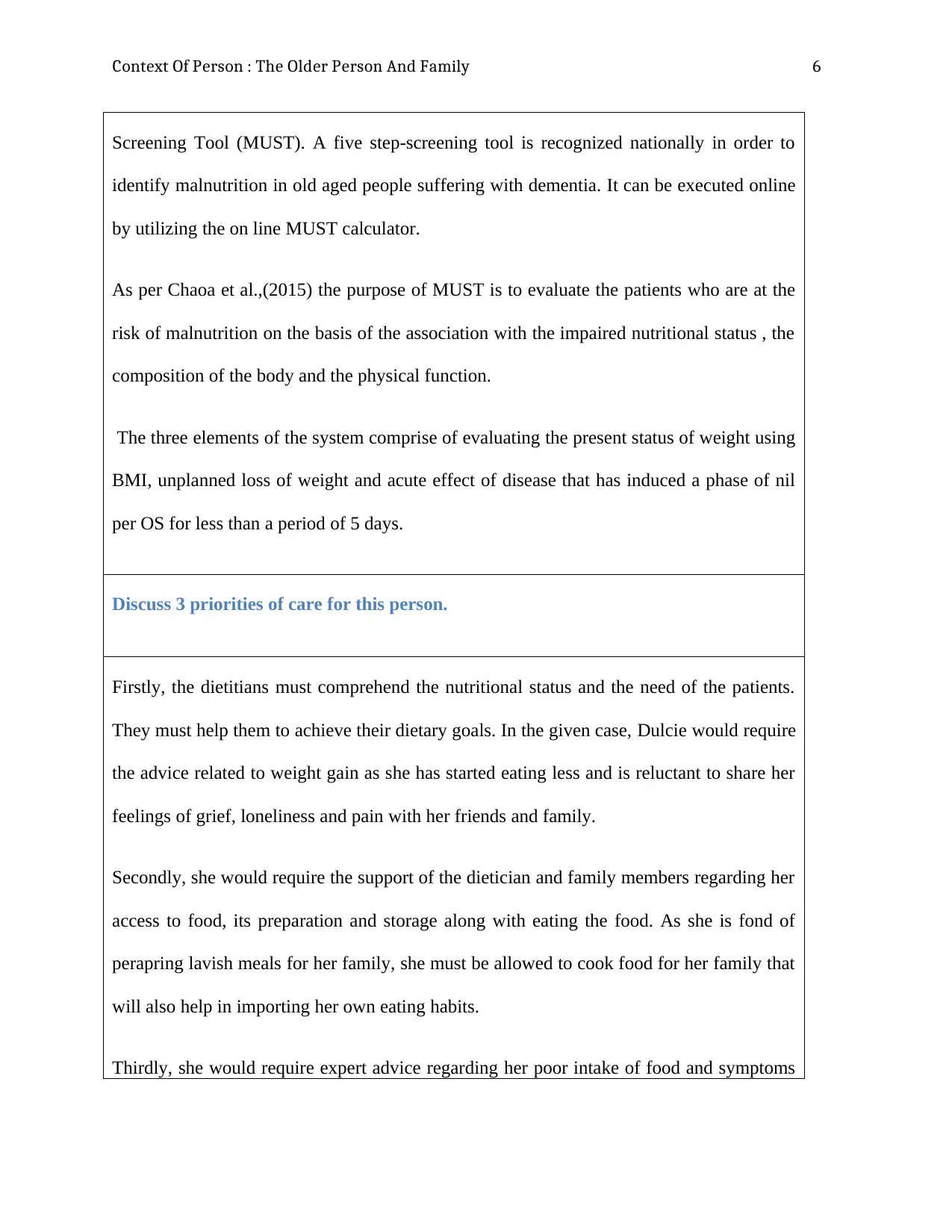
Context Of Person : The Older Person And Family 6
Screening Tool (MUST). A five step-screening tool is recognized nationally in order to
identify malnutrition in old aged people suffering with dementia. It can be executed online
by utilizing the on line MUST calculator.
As per Chaoa et al.,(2015) the purpose of MUST is to evaluate the patients who are at the
risk of malnutrition on the basis of the association with the impaired nutritional status , the
composition of the body and the physical function.
The three elements of the system comprise of evaluating the present status of weight using
BMI, unplanned loss of weight and acute effect of disease that has induced a phase of nil
per OS for less than a period of 5 days.
Discuss 3 priorities of care for this person.
Firstly, the dietitians must comprehend the nutritional status and the need of the patients.
They must help them to achieve their dietary goals. In the given case, Dulcie would require
the advice related to weight gain as she has started eating less and is reluctant to share her
feelings of grief, loneliness and pain with her friends and family.
Secondly, she would require the support of the dietician and family members regarding her
access to food, its preparation and storage along with eating the food. As she is fond of
perapring lavish meals for her family, she must be allowed to cook food for her family that
will also help in importing her own eating habits.
Thirdly, she would require expert advice regarding her poor intake of food and symptoms
Screening Tool (MUST). A five step-screening tool is recognized nationally in order to
identify malnutrition in old aged people suffering with dementia. It can be executed online
by utilizing the on line MUST calculator.
As per Chaoa et al.,(2015) the purpose of MUST is to evaluate the patients who are at the
risk of malnutrition on the basis of the association with the impaired nutritional status , the
composition of the body and the physical function.
The three elements of the system comprise of evaluating the present status of weight using
BMI, unplanned loss of weight and acute effect of disease that has induced a phase of nil
per OS for less than a period of 5 days.
Discuss 3 priorities of care for this person.
Firstly, the dietitians must comprehend the nutritional status and the need of the patients.
They must help them to achieve their dietary goals. In the given case, Dulcie would require
the advice related to weight gain as she has started eating less and is reluctant to share her
feelings of grief, loneliness and pain with her friends and family.
Secondly, she would require the support of the dietician and family members regarding her
access to food, its preparation and storage along with eating the food. As she is fond of
perapring lavish meals for her family, she must be allowed to cook food for her family that
will also help in importing her own eating habits.
Thirdly, she would require expert advice regarding her poor intake of food and symptoms
Paraphrase This Document
Need a fresh take? Get an instant paraphrase of this document with our AI Paraphraser
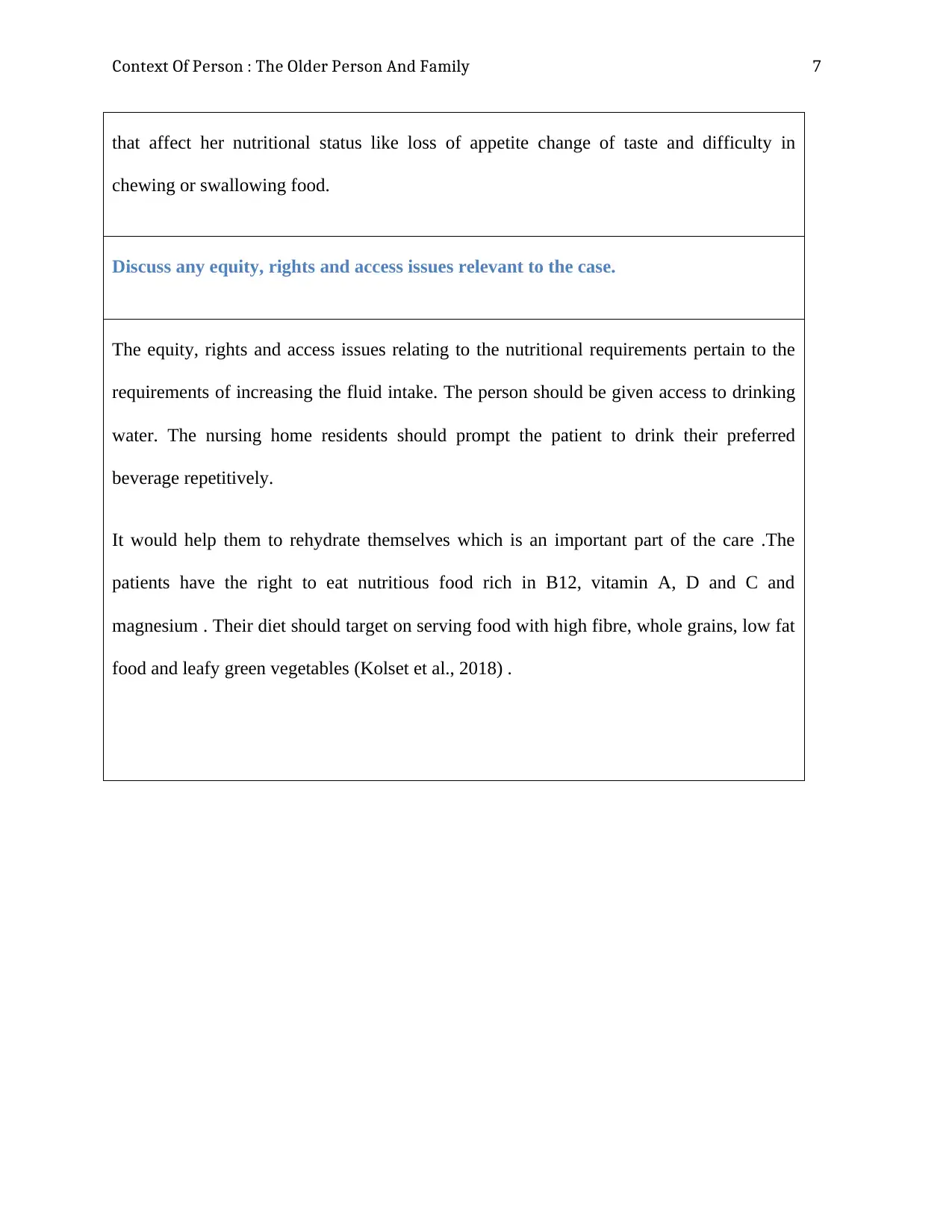
Context Of Person : The Older Person And Family 7
that affect her nutritional status like loss of appetite change of taste and difficulty in
chewing or swallowing food.
Discuss any equity, rights and access issues relevant to the case.
The equity, rights and access issues relating to the nutritional requirements pertain to the
requirements of increasing the fluid intake. The person should be given access to drinking
water. The nursing home residents should prompt the patient to drink their preferred
beverage repetitively.
It would help them to rehydrate themselves which is an important part of the care .The
patients have the right to eat nutritious food rich in B12, vitamin A, D and C and
magnesium . Their diet should target on serving food with high fibre, whole grains, low fat
food and leafy green vegetables (Kolset et al., 2018) .
that affect her nutritional status like loss of appetite change of taste and difficulty in
chewing or swallowing food.
Discuss any equity, rights and access issues relevant to the case.
The equity, rights and access issues relating to the nutritional requirements pertain to the
requirements of increasing the fluid intake. The person should be given access to drinking
water. The nursing home residents should prompt the patient to drink their preferred
beverage repetitively.
It would help them to rehydrate themselves which is an important part of the care .The
patients have the right to eat nutritious food rich in B12, vitamin A, D and C and
magnesium . Their diet should target on serving food with high fibre, whole grains, low fat
food and leafy green vegetables (Kolset et al., 2018) .
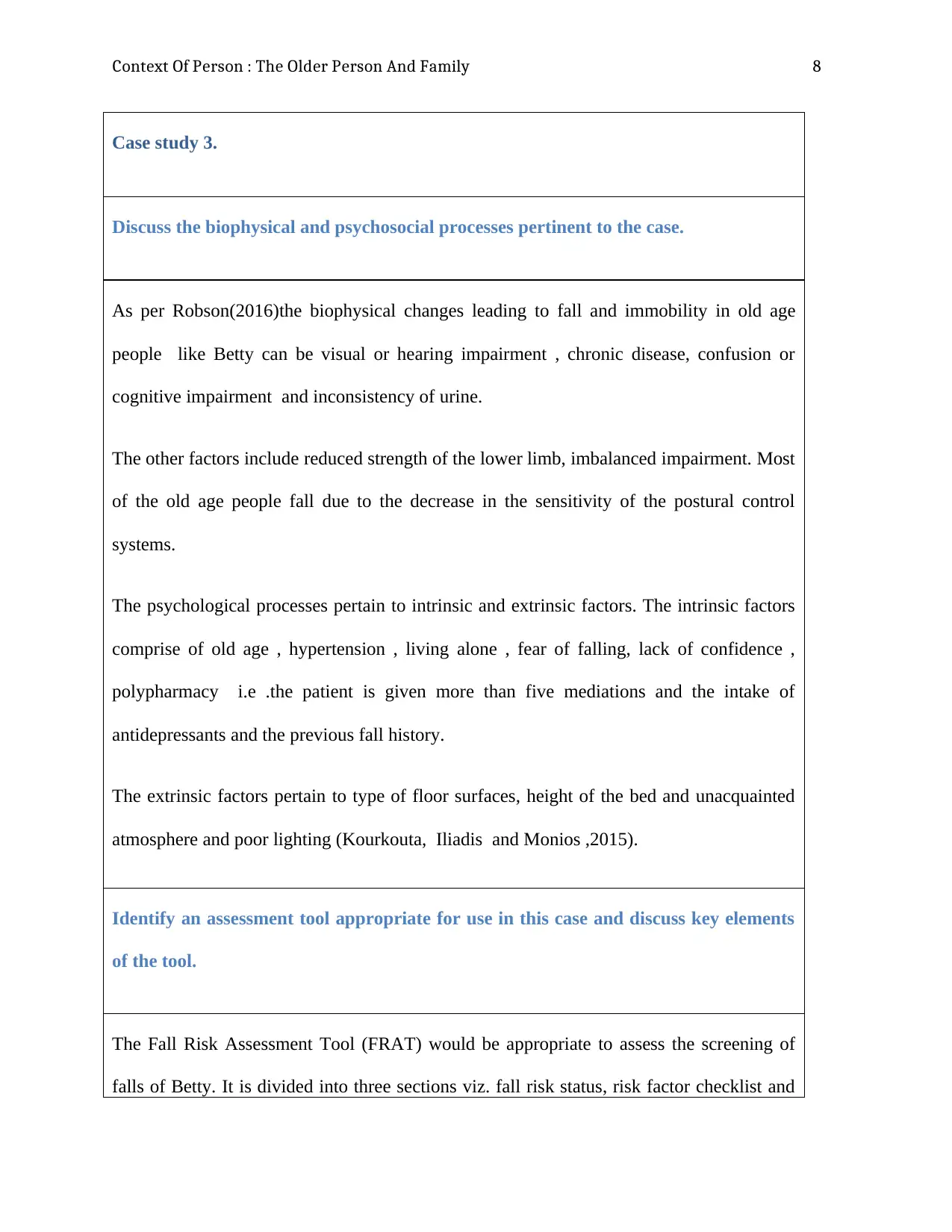
Context Of Person : The Older Person And Family 8
Case study 3.
Discuss the biophysical and psychosocial processes pertinent to the case.
As per Robson(2016)the biophysical changes leading to fall and immobility in old age
people like Betty can be visual or hearing impairment , chronic disease, confusion or
cognitive impairment and inconsistency of urine.
The other factors include reduced strength of the lower limb, imbalanced impairment. Most
of the old age people fall due to the decrease in the sensitivity of the postural control
systems.
The psychological processes pertain to intrinsic and extrinsic factors. The intrinsic factors
comprise of old age , hypertension , living alone , fear of falling, lack of confidence ,
polypharmacy i.e .the patient is given more than five mediations and the intake of
antidepressants and the previous fall history.
The extrinsic factors pertain to type of floor surfaces, height of the bed and unacquainted
atmosphere and poor lighting (Kourkouta, Iliadis and Monios ,2015).
Identify an assessment tool appropriate for use in this case and discuss key elements
of the tool.
The Fall Risk Assessment Tool (FRAT) would be appropriate to assess the screening of
falls of Betty. It is divided into three sections viz. fall risk status, risk factor checklist and
Case study 3.
Discuss the biophysical and psychosocial processes pertinent to the case.
As per Robson(2016)the biophysical changes leading to fall and immobility in old age
people like Betty can be visual or hearing impairment , chronic disease, confusion or
cognitive impairment and inconsistency of urine.
The other factors include reduced strength of the lower limb, imbalanced impairment. Most
of the old age people fall due to the decrease in the sensitivity of the postural control
systems.
The psychological processes pertain to intrinsic and extrinsic factors. The intrinsic factors
comprise of old age , hypertension , living alone , fear of falling, lack of confidence ,
polypharmacy i.e .the patient is given more than five mediations and the intake of
antidepressants and the previous fall history.
The extrinsic factors pertain to type of floor surfaces, height of the bed and unacquainted
atmosphere and poor lighting (Kourkouta, Iliadis and Monios ,2015).
Identify an assessment tool appropriate for use in this case and discuss key elements
of the tool.
The Fall Risk Assessment Tool (FRAT) would be appropriate to assess the screening of
falls of Betty. It is divided into three sections viz. fall risk status, risk factor checklist and
⊘ This is a preview!⊘
Do you want full access?
Subscribe today to unlock all pages.

Trusted by 1+ million students worldwide
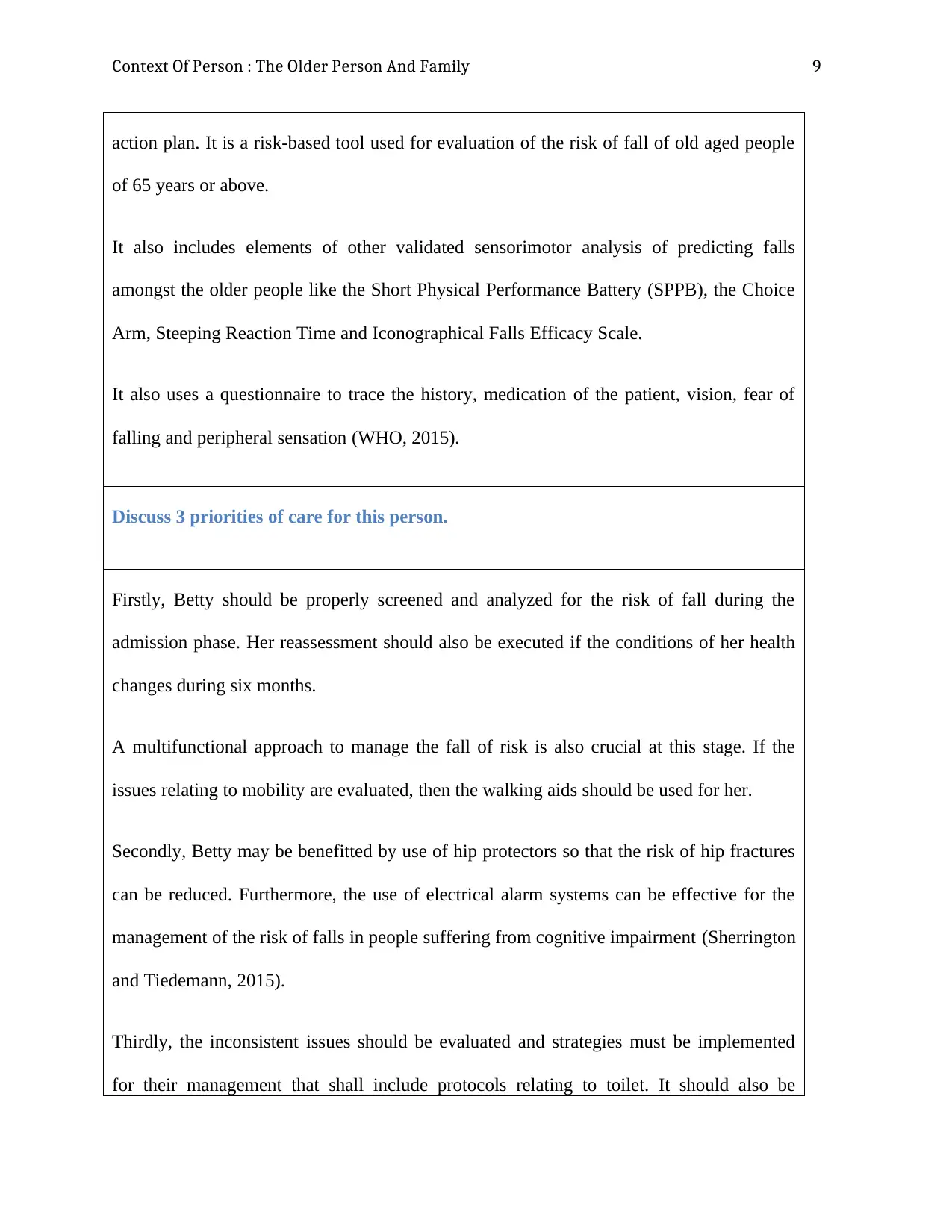
Context Of Person : The Older Person And Family 9
action plan. It is a risk-based tool used for evaluation of the risk of fall of old aged people
of 65 years or above.
It also includes elements of other validated sensorimotor analysis of predicting falls
amongst the older people like the Short Physical Performance Battery (SPPB), the Choice
Arm, Steeping Reaction Time and Iconographical Falls Efficacy Scale.
It also uses a questionnaire to trace the history, medication of the patient, vision, fear of
falling and peripheral sensation (WHO, 2015).
Discuss 3 priorities of care for this person.
Firstly, Betty should be properly screened and analyzed for the risk of fall during the
admission phase. Her reassessment should also be executed if the conditions of her health
changes during six months.
A multifunctional approach to manage the fall of risk is also crucial at this stage. If the
issues relating to mobility are evaluated, then the walking aids should be used for her.
Secondly, Betty may be benefitted by use of hip protectors so that the risk of hip fractures
can be reduced. Furthermore, the use of electrical alarm systems can be effective for the
management of the risk of falls in people suffering from cognitive impairment (Sherrington
and Tiedemann, 2015).
Thirdly, the inconsistent issues should be evaluated and strategies must be implemented
for their management that shall include protocols relating to toilet. It should also be
action plan. It is a risk-based tool used for evaluation of the risk of fall of old aged people
of 65 years or above.
It also includes elements of other validated sensorimotor analysis of predicting falls
amongst the older people like the Short Physical Performance Battery (SPPB), the Choice
Arm, Steeping Reaction Time and Iconographical Falls Efficacy Scale.
It also uses a questionnaire to trace the history, medication of the patient, vision, fear of
falling and peripheral sensation (WHO, 2015).
Discuss 3 priorities of care for this person.
Firstly, Betty should be properly screened and analyzed for the risk of fall during the
admission phase. Her reassessment should also be executed if the conditions of her health
changes during six months.
A multifunctional approach to manage the fall of risk is also crucial at this stage. If the
issues relating to mobility are evaluated, then the walking aids should be used for her.
Secondly, Betty may be benefitted by use of hip protectors so that the risk of hip fractures
can be reduced. Furthermore, the use of electrical alarm systems can be effective for the
management of the risk of falls in people suffering from cognitive impairment (Sherrington
and Tiedemann, 2015).
Thirdly, the inconsistent issues should be evaluated and strategies must be implemented
for their management that shall include protocols relating to toilet. It should also be
Paraphrase This Document
Need a fresh take? Get an instant paraphrase of this document with our AI Paraphraser
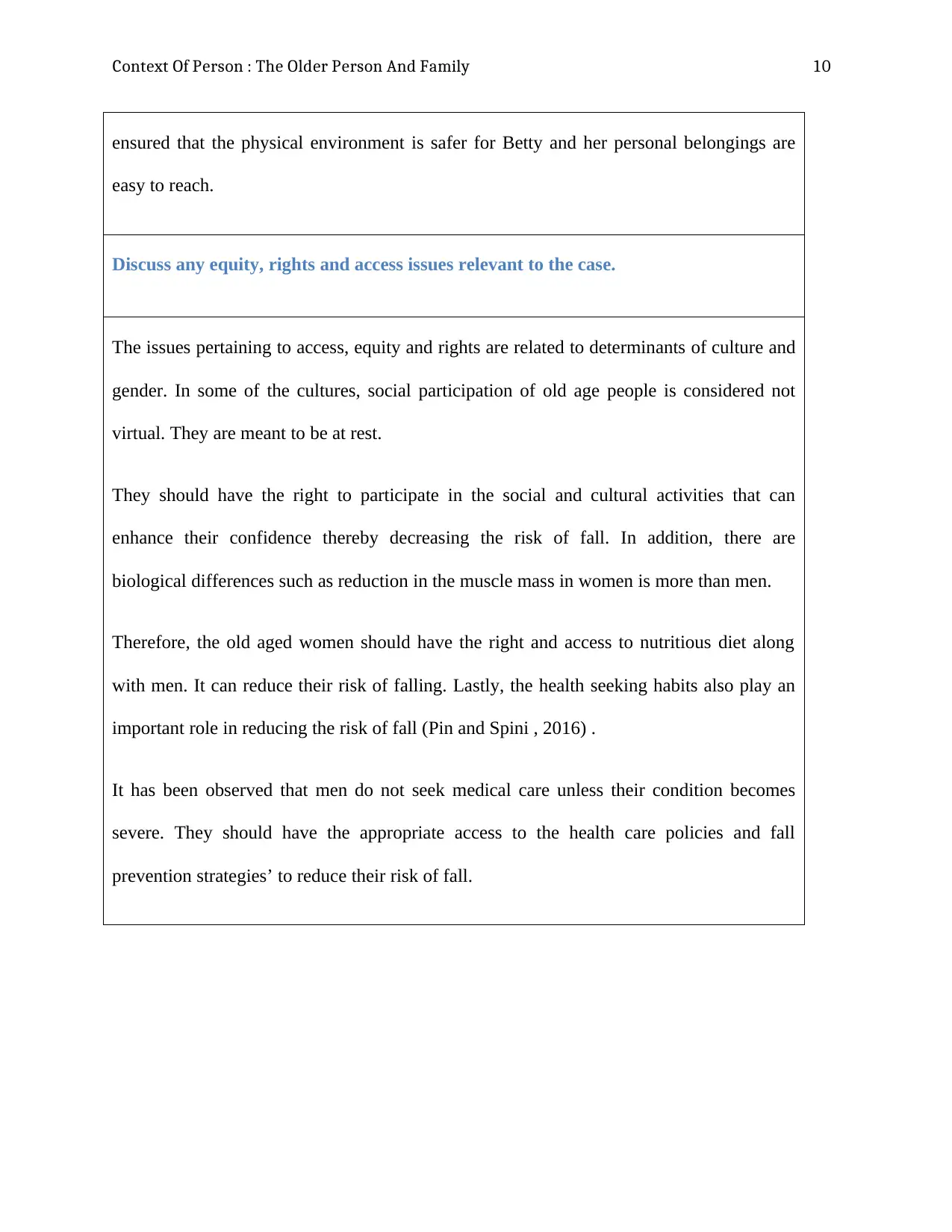
Context Of Person : The Older Person And Family 10
ensured that the physical environment is safer for Betty and her personal belongings are
easy to reach.
Discuss any equity, rights and access issues relevant to the case.
The issues pertaining to access, equity and rights are related to determinants of culture and
gender. In some of the cultures, social participation of old age people is considered not
virtual. They are meant to be at rest.
They should have the right to participate in the social and cultural activities that can
enhance their confidence thereby decreasing the risk of fall. In addition, there are
biological differences such as reduction in the muscle mass in women is more than men.
Therefore, the old aged women should have the right and access to nutritious diet along
with men. It can reduce their risk of falling. Lastly, the health seeking habits also play an
important role in reducing the risk of fall (Pin and Spini , 2016) .
It has been observed that men do not seek medical care unless their condition becomes
severe. They should have the appropriate access to the health care policies and fall
prevention strategies’ to reduce their risk of fall.
ensured that the physical environment is safer for Betty and her personal belongings are
easy to reach.
Discuss any equity, rights and access issues relevant to the case.
The issues pertaining to access, equity and rights are related to determinants of culture and
gender. In some of the cultures, social participation of old age people is considered not
virtual. They are meant to be at rest.
They should have the right to participate in the social and cultural activities that can
enhance their confidence thereby decreasing the risk of fall. In addition, there are
biological differences such as reduction in the muscle mass in women is more than men.
Therefore, the old aged women should have the right and access to nutritious diet along
with men. It can reduce their risk of falling. Lastly, the health seeking habits also play an
important role in reducing the risk of fall (Pin and Spini , 2016) .
It has been observed that men do not seek medical care unless their condition becomes
severe. They should have the appropriate access to the health care policies and fall
prevention strategies’ to reduce their risk of fall.
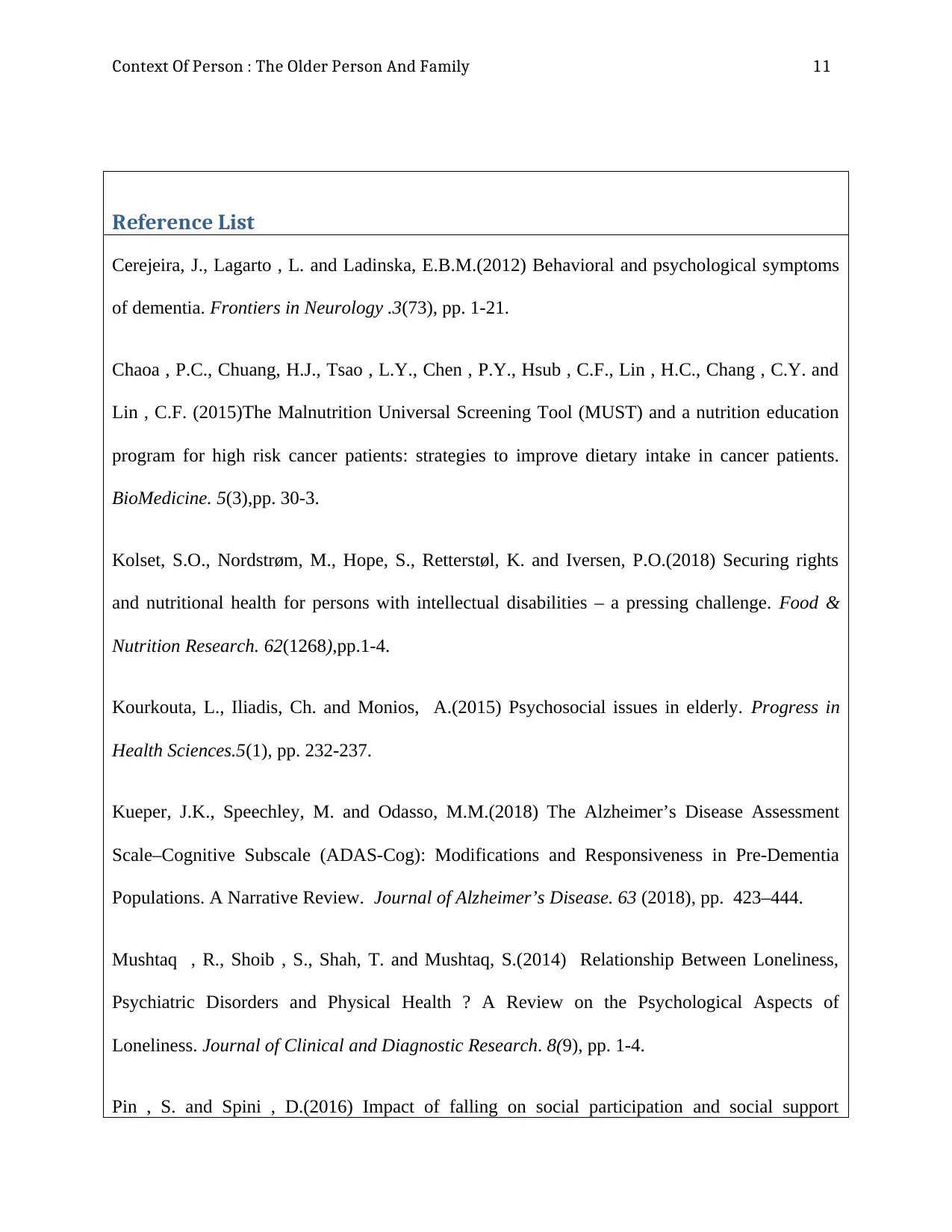
Context Of Person : The Older Person And Family 11
Reference List
Cerejeira, J., Lagarto , L. and Ladinska, E.B.M.(2012) Behavioral and psychological symptoms
of dementia. Frontiers in Neurology .3(73), pp. 1-21.
Chaoa , P.C., Chuang, H.J., Tsao , L.Y., Chen , P.Y., Hsub , C.F., Lin , H.C., Chang , C.Y. and
Lin , C.F. (2015)The Malnutrition Universal Screening Tool (MUST) and a nutrition education
program for high risk cancer patients: strategies to improve dietary intake in cancer patients.
BioMedicine. 5(3),pp. 30-3.
Kolset, S.O., Nordstrøm, M., Hope, S., Retterstøl, K. and Iversen, P.O.(2018) Securing rights
and nutritional health for persons with intellectual disabilities – a pressing challenge. Food &
Nutrition Research. 62(1268),pp.1-4.
Kourkouta, L., Iliadis, Ch. and Monios, A.(2015) Psychosocial issues in elderly. Progress in
Health Sciences.5(1), pp. 232-237.
Kueper, J.K., Speechley, M. and Odasso, M.M.(2018) The Alzheimer’s Disease Assessment
Scale–Cognitive Subscale (ADAS-Cog): Modifications and Responsiveness in Pre-Dementia
Populations. A Narrative Review. Journal of Alzheimer’s Disease. 63 (2018), pp. 423–444.
Mushtaq , R., Shoib , S., Shah, T. and Mushtaq, S.(2014) Relationship Between Loneliness,
Psychiatric Disorders and Physical Health ? A Review on the Psychological Aspects of
Loneliness. Journal of Clinical and Diagnostic Research. 8(9), pp. 1-4.
Pin , S. and Spini , D.(2016) Impact of falling on social participation and social support
Reference List
Cerejeira, J., Lagarto , L. and Ladinska, E.B.M.(2012) Behavioral and psychological symptoms
of dementia. Frontiers in Neurology .3(73), pp. 1-21.
Chaoa , P.C., Chuang, H.J., Tsao , L.Y., Chen , P.Y., Hsub , C.F., Lin , H.C., Chang , C.Y. and
Lin , C.F. (2015)The Malnutrition Universal Screening Tool (MUST) and a nutrition education
program for high risk cancer patients: strategies to improve dietary intake in cancer patients.
BioMedicine. 5(3),pp. 30-3.
Kolset, S.O., Nordstrøm, M., Hope, S., Retterstøl, K. and Iversen, P.O.(2018) Securing rights
and nutritional health for persons with intellectual disabilities – a pressing challenge. Food &
Nutrition Research. 62(1268),pp.1-4.
Kourkouta, L., Iliadis, Ch. and Monios, A.(2015) Psychosocial issues in elderly. Progress in
Health Sciences.5(1), pp. 232-237.
Kueper, J.K., Speechley, M. and Odasso, M.M.(2018) The Alzheimer’s Disease Assessment
Scale–Cognitive Subscale (ADAS-Cog): Modifications and Responsiveness in Pre-Dementia
Populations. A Narrative Review. Journal of Alzheimer’s Disease. 63 (2018), pp. 423–444.
Mushtaq , R., Shoib , S., Shah, T. and Mushtaq, S.(2014) Relationship Between Loneliness,
Psychiatric Disorders and Physical Health ? A Review on the Psychological Aspects of
Loneliness. Journal of Clinical and Diagnostic Research. 8(9), pp. 1-4.
Pin , S. and Spini , D.(2016) Impact of falling on social participation and social support
⊘ This is a preview!⊘
Do you want full access?
Subscribe today to unlock all pages.

Trusted by 1+ million students worldwide
1 out of 13
Related Documents
Your All-in-One AI-Powered Toolkit for Academic Success.
+13062052269
info@desklib.com
Available 24*7 on WhatsApp / Email
![[object Object]](/_next/static/media/star-bottom.7253800d.svg)
Unlock your academic potential
Copyright © 2020–2025 A2Z Services. All Rights Reserved. Developed and managed by ZUCOL.





